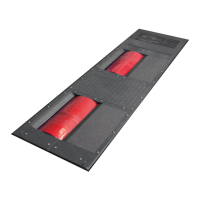BA053101-en
Pos: 279 /Tech nische D okumen tation/A lle G eräte/ Überschr iften/ Übers chrifte n 1.1.1/ F/Übers chrift 1.1.1 : Fahrsim ulat ion @ 13\mod_1234772890274_75.docx @ 339777 @ 3 @ 1
Pos: 280 /Te chnis che D okum ent ati on/ Leis tun gsm esst ech nik/ POWE R DYN O/0 523 01 LPS 3000 R100/BA/Inhalt: 0523 Fahrsimulation @ 23\mod_1297433328959_75.docx @ 975113 @ @ 1
The driving simulation reenacts a road drive and/or a certain load which can be set with the drive
cycles based on specific drive resistances. The test stand range relates primarily to the maximum
speeds of the normal statutory driving cycles from 0 km/h to max. 120 km/h and accelerations in
the range of 1 m/s
2
.
Large masses can be simulated during the acceleration with double and single roller dynamome-
ters.
With deceleration, that is coastdown, only the mechanically existing inertia of ca. 250…300 kg
(LPS 3000); ca. 280/320 kg (MSR 500) and ca. 700 kg (MSR 1000) act per axle with the double
roller set. A higher inertia is not possible with coastdown. In the cycle this results in shorter
coastdown times as those given.
With single dynamometers with drive the possibility arises to simulate electrically between
600…700 kg per axle due to existing drives and an acceleration (deceleration) of 1 m/s².
Consequently, drive simulations in the small speed ranges are possible. Another advantage is that
because of the drives the inherent dyno losses can be identified and stored at any time. The accu-
racy of the load is increased significantly.
Influence of Various Factors
The simulation on the roller set is mainly influenced by the factors rolling and flexing resistance.
On/in a roller set these can be very different as opposed to the road depending on roller diameter
and concept (double or single roller).
Especially at low speeds < 50 km/h the flex and roll resistances of the rollers are larger than the to-
tal resistance on the road. Vehicle weight and tire pressure also play a role. These losses cannot
be compensated without electric motor.
Consequently, there are large deviations in the driving simulation especially in low speed range with
the double roller.
Using the option "Load Adaption" the street coefficients can be adapted to the rollers. As already
mentioned, an adequate adaption can only be done in conjunction with an electric motor. The
MAHA MSR dynamometers with drive can conduct this kind of adaption under the above-named
limits. However, these do not correspond with the industrial standards of emission dynamometers.
The operation mode
Drive Simulation (Road load simulation)
is generator- and motor-driven. The
vehicle-specific drive resistance characteristic including mass simulation is described by the
following simulation model:
)
sin(
d
d
)(
mech
1
ref
3
ref
2
2
α
⋅⋅+
−+
⋅
+
⋅
+
⋅
+=
+
gMasse
t
v
m
Masse
v
vKoeff D
v
v
Koeff C
v
vKoeff B
v
Koeff A
F
Exp D
Exp D
ref
ref
F Tractive force target value
Koeff. A Rolling resistance coefficient (constant)
Koeff. B Flexing resistance coefficient (linear)
Koeff. C
Drag coefficient (square with n ≅ 2)
Koeff. D Drag coefficient (exponential with n being variable)
Exp. D
Exponent D (1 ≤ n ≤ 3, one decimal place)
Masse Vehicle mass
m
mech
Mechanical mass

